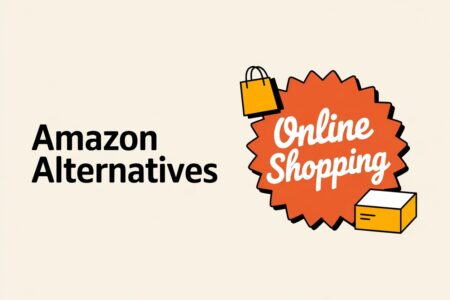Amazon has maintained its monopoly position in United States e-commerce for many years. This is fraught with constant increases in already high commissions, increasing competition from low-quality goods, technical failures, and long correspondence with seller support. We write about these problems based on our personal experience, as we have faced them ourselves. This begs the question: are there worthy alternatives to Amazon for selling products online?
Definitely yes! This article briefly analyzes Amazon alternatives, suitable for different business models, goals, and product categories. We will look at the pros and cons of each platform, fee structures, and requirements for sellers, to help you to make informed decisions for your online business.
Why Should You Consider Amazon Alternatives for Online Sales?
As an online seller, you’ve likely experienced the immense reach and convenience that Amazon offers. However, relying solely on the retail giant can be risky. Diversifying your sales channels is crucial for long-term success.
The massive customer base of Amazon is good, but it isn’t a “magic wand”. Here’s why some sellers might want to find alternatives:
- High Fees. Amazon’s fee structure can “eat” your profit margins, especially if you are a private-label seller or sell oversize products.
- Expensive Ads. New product listings require large investments in advertising. It is needed on an ongoing basis.
- Competition. A huge number of sellers on Amazon makes it challenging to stand out, particularly for niche products.
- Limited Control. Platform dictates many aspects of the customer experience, restricting your ability to build brand loyalty.
- Platform Complexity. Navigating ever-changing policies and algorithms can be not easy. Creating and loading flat files and unlocking restricted categories may be especially challenging.
- Technical Glitches. Products with many variations (sizes, colors) often face the problem of ungrouping listings. Do not expect that the seller support will quickly help you with this, or compensate for the financial damage from lost sales.
- Punishing Third-Party Sellers who offer lower prices for products on their own websites.
- Data Collection and Monopoly. Online marketplace collects data from third-party sellers, so there is a risk that it uses it to compete against them.
KEY TAKEAWAYS
- Sell your products across multiple marketplaces to reach different customer bases.
- Many Amazon alternatives offer more control over product listing and branding, allowing you to build a stronger brand identity.
- Reduced fees and potentially higher customer loyalty due to a more personalized experience can lead to better profit margins.
- Selling outside of marketplaces requires more attention to taxes and logistics.
- Integrations allow you to sell on several platforms like Amazon simultaneously.
Choosing Alternatives to Amazon for Ecommerce Businesses
Before starting selling on a new platform, it’s crucial to identify your needs as a seller. Here are some key factors to consider when choosing an alternative platform:
- Target Audience. Who are you selling to? What’s the portrait of your potential customer? Different platforms focused on specific buyers’ interests and demographics.
- Product Category. Align your platform choice with the products you sell. Consider the platform’s niche focus, because they are not the same. Some specialize in specific product categories, while others are more general (multi-niche websites).
- Business Model. Are you a manufacturer that sells its products under own brand? Or are you the owner of a private label for which manufacturers produce goods, and who needs a place to store the purchased items? Or are you a dropshipper who resells other’s goods? Base your choice on products your online business sells: high-volume, low-profit, or premium handmade goods. Choose a marketplace or a platform with commission that best suits your business model.
- Fulfillment Capabilities. Do you plan to fulfill orders yourself (FBM supply model) or outsource to a fulfillment service (use an analog of FBA)? Consider the platform’s fulfillment options. Some Amazon alternatives have their own Fulfillment by Amazon substitute, for others, you will need to use 3PL services.
- Seller Fees. Compare listing, transaction, storage, and fulfillment fees across different platforms. Understanding all future costs will help you calculate your potential profit margins and determine the competitiveness of your products compared to the similar listings of competitors.
- Brand Control. Do you prioritize building brand awareness or only need a platform to move products? Some sites offer additional features for branding.
- Level of Control and Promotion. How much control do you have over your listings and customer experience? Are there any built-in marketing tools?
- Difficulty and Technical Expertise. How easy is it to manage your online store (especially if you are a beginner)? Do you need any technical skills for the website setup and maintenance?
- Scalability. Consider your future growth plans. Choose a platform that can scale alongside your e-commerce business without significant limitations.
- Seller Support. Availability of resources, forums, and assistance for online sellers.
Top Alternatives to Amazon for Selling Online
Amazon alternatives can be divided into 2 types: ecommerce platforms and online marketplaces. Some of them are for niche sellers, others — are general. Each has advantages and disadvantages. For example, facilitators (online marketplaces) are now responsible for collecting and remitting sales taxes on behalf of your sales in applicable states due to marketplace facilitator laws. While your website gives you unlimited opportunities in how to present your product to the client. Below you will find both.
1. Building Your Own Ecommerce Store (any niche)
Creating your own online store gives you the most control over your brand identity and doesn’t limit you in what you sell. To create a website, you have several options: order website development from scratch, or use website builders. Choose the option that is most suitable for your business model: use a self-hosted website or use such services. Platforms like Shopify, Wix, and WooCommerce offer user-friendly tools to create a customized online storefront.
Ecommerce Website Developed From Scratch
Best for large assortments of thousands of items. Suitable for selling any type of product or service.
Pros:
- Complete control over branding, product descriptions, and pricing.
- Direct customer relationships and data ownership.
- Flexibility to integrate marketing tools and build brand loyalty.
- Easy to scale.
Cons:
- Requires investment in website design, development, and further maintenance.
- Driving traffic to your store can be challenging, requiring SEO and marketing efforts.
- Collecting and paying sales taxes is on you.
- Fulfillment logistics and customer service is your responsibility.
Ideal for: Established businesses, brands with unique value propositions, and sellers seeking long-term brand building.
Costs: Vary depending on the hosting and required capacities. Yearly (or monthly) hosting fees, transaction fees, and price of a domain.
WooCommerce (plugin for WordPress)
WooCommerce is a popular open-source e-commerce plugin for WordPress websites that offers many customizations but requires some technical knowledge.
Pros:
- Free to use and highly customizable.
- Integrates seamlessly with WordPress websites.
- Offers a wide range of extensions for added functionality.
- Self-hosted store.
- No restrictions on what you can sell.
Cons:
- Requires technical knowledge for setup, maintenance, and security. But many guides make it easier.
- Hosting and security is your responsibility.
- Limited support compared to hosted ecommerce platforms like Shopify.
Ideal for: Digitally proficient entrepreneurs, developers comfortable with WordPress, and businesses seeking a highly customizable solution. A good option for sellers with existing WordPress websites.
Costs and Fees: Free to use. Requires additional costs for hosting, themes, plugins, extensions, and security.
Shopify
A global commerce company that provides its services to millions of merchants in more than 175 countries. Shopify is a cloud-based and hosted platform that allows you to create professional, scalable online stores. It offers a comprehensive set of tools for design, managing products, inventory, accepting payments, and marketing.
Shopify has multiple integrations to sell across sites like Amazon, Walmart, eBay, and Etsy.
Pros:
- User-friendly platform with many features and integrations.
- Highly customizable storefront design for complete brand control.
- Scalable solution to accommodate business growth.
Cons:
- Monthly subscription fees can add up, impacting profit margins.
- Requires some technical knowledge for setting up and managing the store.
- Transaction fees apply on top of the monthly subscription.
Ideal for: Established businesses, dropshippers, entrepreneurs seeking a scalable ecommerce solution, and sellers with a strong brand identity. A good choice for selling anything from apparel and electronics to digital downloads and subscriptions.
Fees: Monthly subscription fee (plans vary depending on features), transaction fees (percentage of sale), and shipping label fees. Prices start at $32 for the Basic monthly plan ($24/month if you pay annually) which is best for solo entrepreneurs and starting at $2,300/month (for the Plus plan) if you have a complex business.
2. Walmart Marketplace
Walmart Marketplace is one of those websites like Amazon that have the most similar functionality and set of rules for sellers. Second largest ecommerce marketplace in the United States is a great option for sellers of everyday essentials, FMCGs, and competitively priced goods.
Pros:
- Access to millions loyal to Walmart shoppers.
- Potential for higher sales volume due to large audience.
- Competitive commission rates compared to Amazon.
- The burden of sales tax collection is on Walmart.
- Integration with physical stores.
- Sponsored search features.
Cons:
- Intense focus on price competitiveness; thin margins may be an issue.
- Strict performance metrics and potential account suspensions for non-compliance.
- Limited branding opportunities compared to some other platforms.
- May not be ideal for sellers of unique or premium products.
Ideal for: Sellers of everyday consumer goods, bulk items, and competitively priced products. Businesses with a strong fulfillment infrastructure.
Costs: Referral fees (5-20% of selling price) vary by product category. May include additional closing fees and per-item fees. Walmart Fulfillment Services (WFS) fees (start from $3.45 for standard items) or additional costs for third-party fulfillment (with returns capability).
3. eBay
A giant in online auctions and sales, eBay offers a vast audience and the flexibility of auction and fixed-price listings. With 132 million buyers in more than 190 markets around the world, eBay is a place where you can sell both new (about 80% of the listings are brand-new items) and used items. It’s great for selling rare collectibles, unique, and vintage items but can be more competitive for mass-produced goods (like brand-new electronics). Check what makes it a viable Amazon alternative below.
Pros:
- Broad audience reach, attracting bargain hunters and collectors.
- Option for auction-style listings, creating bidding hype and potentially higher profits.
- Established platform with a loyal user base.
- Access analytics, inventory management, and promotional features.
- You can sell anything (besides restricted or illegal items).
Cons:
- Wild competition, especially for popular items.
- Auction format can lead to lower, unpredictable selling prices.
- Higher final value fees compared to some competitors.
Ideal for: Sellers with a diverse product mix, including collectibles, used and vintage items. Businesses comfortable with an auction format.
Costs: Listing fees (up to 250 zero insertion fee per month) vary depending on the format (auction vs. fixed price) and category. Final value fees (percentage of selling price + per order): per order fee is $0.30 for orders below $10.00, and $0.40 for orders over $10.00. Transaction fees.
4. Etsy
If you specialize in arts and crafts, handmade, vintage, or unique products, Etsy is an excellent choice. Currently, the site has over 96 million active buyers. It’s known for its creative community and buyers seeking one-of-a-kind items. This makes it a good Amazon alternative for selling such goods. Additionally, this is a great place to sell digital products: planners, invitations, themes, patterns, etc.
Pros:
- Large, established customer base specifically looking for unique items.
- Strong focus on handmade and vintage products.
- Relatively low listing fees and commission rates.
- Personalization products for buyers (customization).
Cons:
- Limited product categories compared to Amazon.
- More competitive landscape for saturated product niches.
- May not be ideal for high-volume sellers.
Ideal for: artists, crafters, vintage resellers, sellers of unique, handcrafted goods, print on demand business.
Costs: $0.20 listing fee per item, 6.5% commission on sales, and payment processing fee. To open a new Etsy shop, you must pay a one-time set-up fee of $15.
5. Google Shopping
While not a traditional marketplace, Google Shopping allows sellers to list their products directly on Google. It’s a powerful channel for reaching potential buyers. We strongly recommend Google Shopping as an Amazon alternative for your sales strategy.
There are two main ways to add your products to Google Shopping:
- Manually through Google Merchant Center (GMC), which acts as a hub for all your product information. You can then manually add each product with details like title, description, image URL, price, and more. This is suitable for sellers with a small inventory, but it can be time-consuming for larger catalogs.
- Using a product feed. This method involves creating a file (spreadsheet, .xml) containing all your product information in a specific format required by Google and uploading this file to GMC. This is much faster and more efficient for sellers with a large inventory or those who frequently update their products.
Pros:
- High visibility to potential buyers during their search queries.
- Attracting nearby shoppers to your physical store.
- Targeted advertising.
- Free listings.
Cons:
- It may be too competitive for new sellers or for selling in crowded categories.
- Paid advertising can be expensive, and it takes time to optimize your campaigns.
- Efforts to keep your product listings up-to-date.
Ideal for: Sellers with competitive prices, high-quality product images and descriptions, good profit margins, niche online stores.
Costs: Free product listings with advertising costs for paid placements.
6. Facebook Marketplace and Facebook Shops
Facebook Marketplace is a built-in online marketplace within the Facebook platform. It allows users to buy and sell a variety of items locally, leveraging their existing social network. Facebook Shops offers an integration with existing social media presence and has Facebook and Instagram targeting capabilities. Marketplace is more like a giant online garage sale, and Shops is like having your own online store.
Pros:
- Huge user base for targeted local reach.
- Easy to list and sell items with a familiar Facebook interface.
- No listing fees.
Cons:
- Primarily focused on local sales, limiting reach for some products.
- Less secure payment system compared to dedicated marketplaces.
- Buyer pool may be less qualified or professional compared to other platforms.
- Selling fee.
Ideal for: selling used or unwanted items, locally made crafts, or furniture, visually appealing items that can benefit from social media promotion. Businesses looking to supplement sales with a local customer base.
Costs: Free listings; commission fee applied to completed sales. Free to set up a shop, but advertising costs may apply.
7. Bonanza
Bonanza is a seller-centric marketplace that charges a low 3.5% commission per sale (no listing or other sneaky fees). It allows easy product imports from Amazon, eBay, Etsy, Shopify, or inventory files. This is a good alternative site for selling clothes, home and garden goods, collectibles, and handcrafted items. The main focus is on budget-conscious shoppers. Its 2 million monthly niche audience is quite low compared to ecommerce leaders, but on the other hand, there are fewer competitors here, so if you have a low-margin product, you have every chance of getting your sales.
Beyond Amazon: Success on Alternative Platforms
Choosing the right platform is just the first step. Here are some additional tips to thrive on your chosen Amazon alternative:
- Product Optimization. Ensure your product listings are high-quality, informative, and optimized for search on the chosen platform.
- Compelling Content. Craft engaging product descriptions, use high-resolution product photos, and consider offering informative videos or tutorials.
- Customer Service. Provide excellent customer service to build trust and loyalty. Respond promptly to inquiries, address issues efficiently, and go the extra mile to delight customers.
- Marketing and Branding. Develop a strong brand identity that resonates with your target audience. Utilize the platform’s marketing tools and explore additional marketing channels like social media or email marketing.
- Analytics and Optimization. Track your performance on the platform, analyze customer behavior, and continuously optimize your listings, pricing, and marketing strategies for better results.
Conclusion
While Amazon offers a massive marketplace, diversifying your sales channels can unlock significant benefits. By exploring Amazon alternatives, you gain more control over branding, potentially reduce fees, and target your ideal customer more effectively. You can increase profit margins, get a stronger brand identity, and a loyal target audience. We wish you luck in your selling experience!



